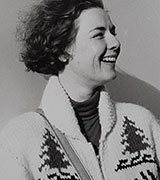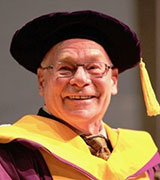The NCA Team
Contact the NCA
519-661-3901
info@nca.uwo.ca
Elborn College - Room 2262
1201 Western Road
London, Ontario N6G 1H1
Past Members
Since it was established in 2001, the National Centre for Audiology has been home to some of the field's most influential scientists. The success of the NCA was shaped by many scholars who are no longer members of the NCA, but will forever be remembered as having shaped the future of teaching and research in the area of hearing science.
Mary Beth Jennings
 Hailing from Sudbury, Ontario, Dr. Jennings completed undergraduate studies in Psychology (Laurentian), clinical studies in Audiology (Western), and her Ph.D. in Rehabilitation Sciences (Western). Throughout her life she maintained a wide range of international friendships and collaborations, and rich interests in music, figure skating, cooking, plants, and shared her life with her partner Craig. Mary Beth passed away in 2020 and is greatly missed. Her full obituary is available here.
Hailing from Sudbury, Ontario, Dr. Jennings completed undergraduate studies in Psychology (Laurentian), clinical studies in Audiology (Western), and her Ph.D. in Rehabilitation Sciences (Western). Throughout her life she maintained a wide range of international friendships and collaborations, and rich interests in music, figure skating, cooking, plants, and shared her life with her partner Craig. Mary Beth passed away in 2020 and is greatly missed. Her full obituary is available here.
Dr. Jennings was our resident expert in providing aural rehabilitation services for adults with hearing loss, family-centred care and counselling, and accessibility from a number of perspectives. Her clinical work was devoted to these areas during her 12 years of clinical service at the Canadian Hearing Society, and she masterfully translated her clinical expertise to her teaching and program of research as a faculty member at Western. Her teaching integrated her research and clinical expertise and led her to develop a novel program of research-linked clinical care in adult aural rehabilitation. Her research contributions were substantial and included the Self-efficacy for Situational Communication for Management Questionnaire (SESMQ), book chapters, peer-reviewed articles, and the sharing of her skills and knowledge through presentations and collaborations both nationally and internationally. More information on Mary Beth’s career, including remembrances from her colleagues, can be found here. Links to her lifetime research contributions are available on ResearchGate and Scopus.
Richard Seewald
 Dr. Richard Seewald contributed research findings in pediatric amplification for more than 25 years. After beginning his career as a clinical audiologist in Halifax, he worked during the rubella epidemic of the 1970’s which caused a major increase in the prevalence of permanent childhood hearing loss in his local area. Frustrated by the lack of effective clinical tools and procedures available to meet the needs of these children, he returned to school to complete his doctorate under the guidance of his mentor, Dr. Mark Ross, who was himself a user of hearing aids. Their paper entitled “Selecting Amplification Characteristics for Young Hearing-Impaired Children” quickly became a classic in pediatric audiology. His critical approach to determine the amplification needs for infants and young children raised the bar in pediatric hearing aid research. Dr. Seewald’s Desired Sensation Level Approach (DSL) hearing aid fitting method is used worldwide to ensure that infants and children receive appropriate amplification for loudness comfort and speech-language development. Through the 1990’s Dr. Seewald collaborated extensively with Shane Moodie and Sheila Sinclair (now Moodie) to develop and validate child-friendly uses of on-ear hearing aid verification systems, with Leonard Cornelisse to adapt DSL for use with level-dependent hearing aid signal processing, and with Ketan Ramji to program DSL version 4. Dr. Seewald continued to refine his recommendations and assess their validity to improve the ability of clinicians to provide optimal hearing aid fittings for infants and children, with specific support as the Canada Research Chair (Tier 1) in Childhood Hearing. This supported collaborations with Susan Scollie, Marlene Bagatto, and Sheila Moodie to develop adaptions of DSL methods for use with infants, which were ultimately programmed into DSLv5 by software developer Steve Beaulac. His collaborations with Lorienne Jenstad shed new light into using the DSL method with adults who use hearing aids, a line of research that she has continued and grown in her work at UBC. Dr. Seewald was also an excellent teacher and mentor of students and practicing clinicians that audiology care for infants and young children is a science and an art. Dr. Seewald not only has an excellent understanding of technologic and theoretical issues, but he also is a clinician with the compassion and interpersonal skills to work with children and their families. Dr. Seewald has brought his research finding into the clinic of every pediatric audiologist. Richard continues to live in London where he enjoys choral music, spending time with his grandchildren, and continues to keep in touch with colleagues at the National Centre for Audiology.
Dr. Richard Seewald contributed research findings in pediatric amplification for more than 25 years. After beginning his career as a clinical audiologist in Halifax, he worked during the rubella epidemic of the 1970’s which caused a major increase in the prevalence of permanent childhood hearing loss in his local area. Frustrated by the lack of effective clinical tools and procedures available to meet the needs of these children, he returned to school to complete his doctorate under the guidance of his mentor, Dr. Mark Ross, who was himself a user of hearing aids. Their paper entitled “Selecting Amplification Characteristics for Young Hearing-Impaired Children” quickly became a classic in pediatric audiology. His critical approach to determine the amplification needs for infants and young children raised the bar in pediatric hearing aid research. Dr. Seewald’s Desired Sensation Level Approach (DSL) hearing aid fitting method is used worldwide to ensure that infants and children receive appropriate amplification for loudness comfort and speech-language development. Through the 1990’s Dr. Seewald collaborated extensively with Shane Moodie and Sheila Sinclair (now Moodie) to develop and validate child-friendly uses of on-ear hearing aid verification systems, with Leonard Cornelisse to adapt DSL for use with level-dependent hearing aid signal processing, and with Ketan Ramji to program DSL version 4. Dr. Seewald continued to refine his recommendations and assess their validity to improve the ability of clinicians to provide optimal hearing aid fittings for infants and children, with specific support as the Canada Research Chair (Tier 1) in Childhood Hearing. This supported collaborations with Susan Scollie, Marlene Bagatto, and Sheila Moodie to develop adaptions of DSL methods for use with infants, which were ultimately programmed into DSLv5 by software developer Steve Beaulac. His collaborations with Lorienne Jenstad shed new light into using the DSL method with adults who use hearing aids, a line of research that she has continued and grown in her work at UBC. Dr. Seewald was also an excellent teacher and mentor of students and practicing clinicians that audiology care for infants and young children is a science and an art. Dr. Seewald not only has an excellent understanding of technologic and theoretical issues, but he also is a clinician with the compassion and interpersonal skills to work with children and their families. Dr. Seewald has brought his research finding into the clinic of every pediatric audiologist. Richard continues to live in London where he enjoys choral music, spending time with his grandchildren, and continues to keep in touch with colleagues at the National Centre for Audiology.
M.F. Cheesman
Dr. Cheesman retired after making significant contributions to the NCA as one of its founding members and the Director of the Hearing Science Lab, where she studied psychoacoustics, noise exposure, and the relationships between aging and hearing in collaboration with colleagues including Dr. Mary Beth Jennings. Well known for her savvy in using precision calibration equipment, quilting, and hearing science, Dr. Cheesman’s attention to detail always brought those seeking advice from one who could be counted on to share knowledge and know-how. She was the lead developer of the Canadian Distinctive Features Differences test (UWO-DFD) which remains in use today as a highly sensitive measure of phoneme recognition in labs at Western and elsewhere. A strong administrator and program building, Dr. Cheesman was instrumental in growing the undergraduate Health Studies program at Western during her years as its Chair, and contributed to the formation and growth of the Ph.D. program in the Hearing Sciences field at Western, part of Health and Rehabilitation Sciences.
Don Jamieson
Dr. Jamieson studied developmental psychology and mathematics at the University of British Columbia and experimental psychology and mathematics at Carleton University, receiving his PhD in 1976. He was a faculty member at the University of Calgary from 1976 to 1987, serving as Head of the Department of Psychology from 1981 to 1985. At Calgary he led the NSERC-funded team that developed the Canadian Speech Research Environment (CSRE) software system, adopted by spoken language researchers in more than 50 countries. From 1985 to 1987 he was a visiting fellow at the Waisman Centre on human development, University of Wisconsin (Madison). He moved to Western in 1987, chairing the Department of Communicative Disorders until 1992, serving as Director of the Ontario Ministry of Health-funded Hearing Health Care Research Unit from 1989 until 1999, and as founding Director of the National Centre for Audiology (NCA) from 1999 until 2005. He led the Hearing Team of the Ontario Rehabilitation Technology Consortium (funded by the Ontario Ministry of Health) from 1989 until 2003. In 1993, he led the group that formed Avaaz Innovations Inc., a UWO spin-off company that developed software for research and clinical purposes.

